Laid down December 6, 1985 Launched 4 December 1988 Draft 10 m | Ordered 1983 Construction started 6 December 1985 Length 304 m Beam 38 m | |
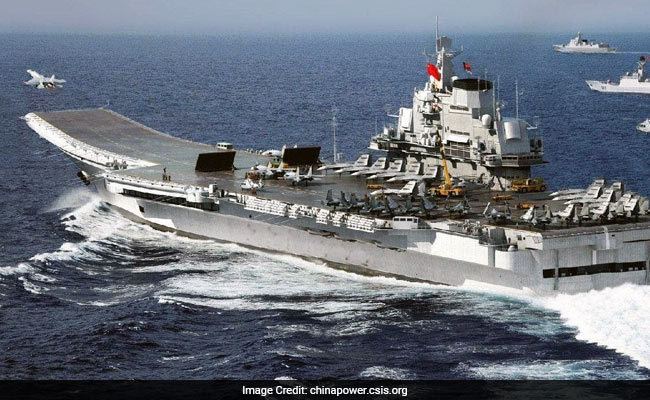 | ||
Namesake Imperial Russian cruiser Varyag Completed Abandoned (68% complete) Builder Dalian Shipbuilding Industry Company | ||
Chinese aircraft carrier liaoning carries out drill with j 15 jets on board
Liaoning (16; Chinese: 辽宁舰; pinyin: Liáoníng Jiàn) is the first aircraft carrier commissioned into the People's Liberation Army Navy Surface Force. It is classified as a training ship, intended to allow the Navy to experiment and gain familiarity with aircraft carrier operations.
Contents
- Chinese aircraft carrier liaoning carries out drill with j 15 jets on board
- Chinese aircraft carrier liaoning leads south china sea exercises
- Classification
- Origin
- Sale
- Transfer to China
- Modernization and refit
- Sea trials and handover
- Aircraft handling
- References
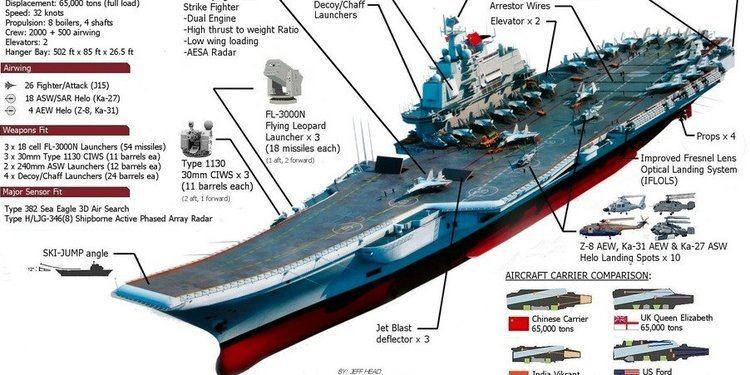
Originally laid down in 1985 for the Soviet Navy as the Kuznetsov-class aircraft cruiser Riga, she was launched on December 4, 1988 and renamed Varyag in 1990. After the dissolution of the Soviet Union in 1991, construction was halted and the ship was put up for sale. The stripped hulk was purchased in 1998 and towed to the Dalian naval shipyard in northeast China.
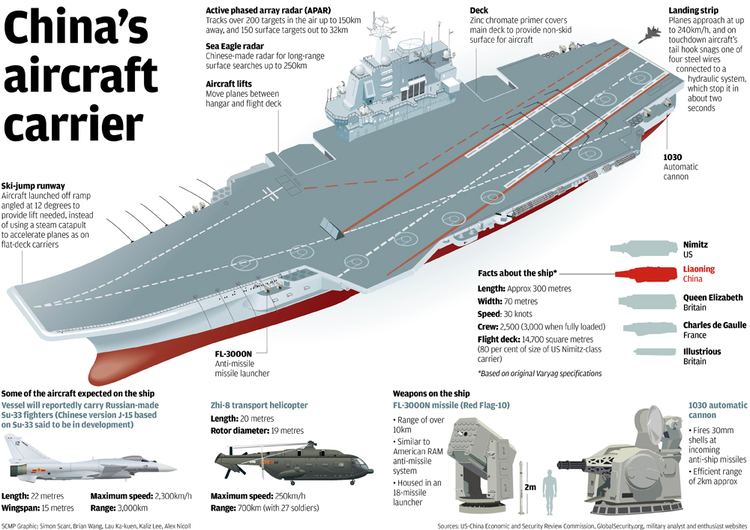
The ship was rebuilt and commissioned into the People's Liberation Army Navy (PLAN) as Liaoning on September 25, 2012. Its Chinese ship class designation is Type 001. In November 2016, the political commissar of Liaoning, Senior Captain Li Dongyou, stated that Liaoning was combat ready.
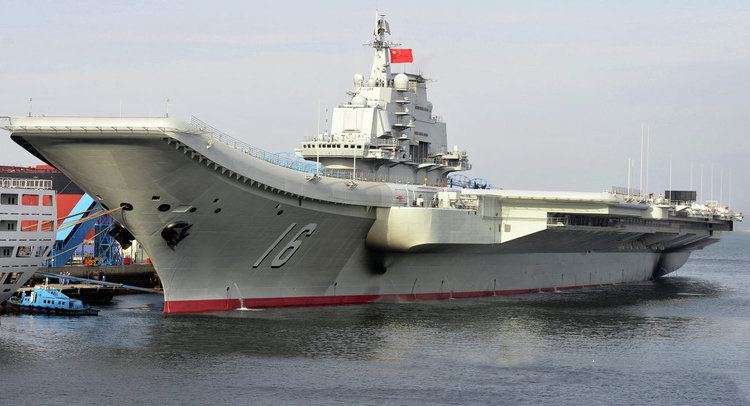
Chinese aircraft carrier liaoning leads south china sea exercises
Classification

The Kuznetsov-class ships were originally designated by the Soviet Navy as "тяжёлый авианесущий крейсер" tyazholiy avianesushchiy kreyser (TAKR or TAVKR) "heavy aircraft-carrying cruiser." In addition to aircraft, the ships were designed to carry P-700 Granit anti-ship cruise missiles that also form the main armament of the Kirov-class battlecruiser. This multirole capability was very important, as it allowed the ships to pass through the Turkish Straits between the Black Sea and the Mediterranean Sea. Under the Montreux Convention, aircraft carriers are restricted to 15,000 tons, but there was no displacement limit on capital ships from Black Sea powers.
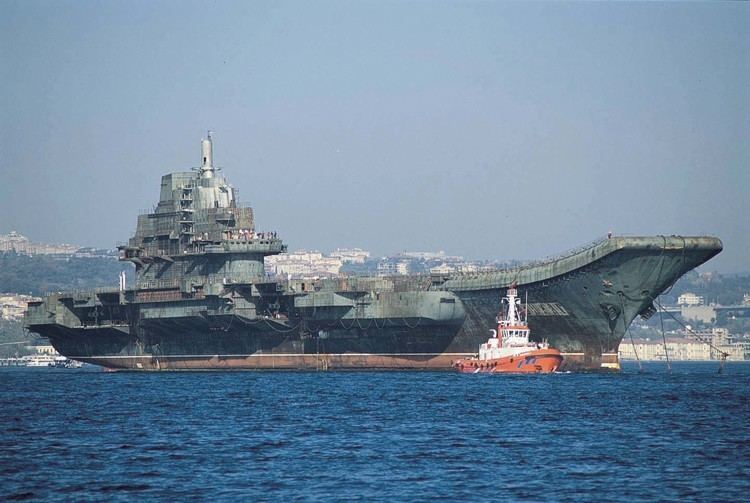
The Chinese Navy considers Liaoning to be an aircraft carrier. Since China is not located on the Black Sea, it does not need and cannot use the tonnage exemption for capital ships. The ship was completed as an aircraft carrier, and cruise missiles were never installed. Liaoning is equipped only with air defense weapons and must use its aircraft for surface attack.
Origin
The ship was laid down as Riga at Shipyard 444 (now Mykolaiv South) in Mykolaiv, Ukrainian SSR, on December 6, 1985. Design work was undertaken by the Nevskoye Planning and Design Bureau. Launched on December 4, 1988, the carrier was renamed Varyag in late 1990, after the famous cruiser. When the Soviet Union collapsed in 1991, the ship was put up for sale, as construction halted at 68% complete.
Sale

Ukraine approached China, India, and Russia as potential buyers. China sent a high-level delegation in 1992, which reported that the ship was in good condition and recommended a purchase. However, the Beijing leadership declined to purchase the ship because of the international diplomatic situation at the time. Unable to find a buyer, Ukraine left the ship to deteriorate in the elements.
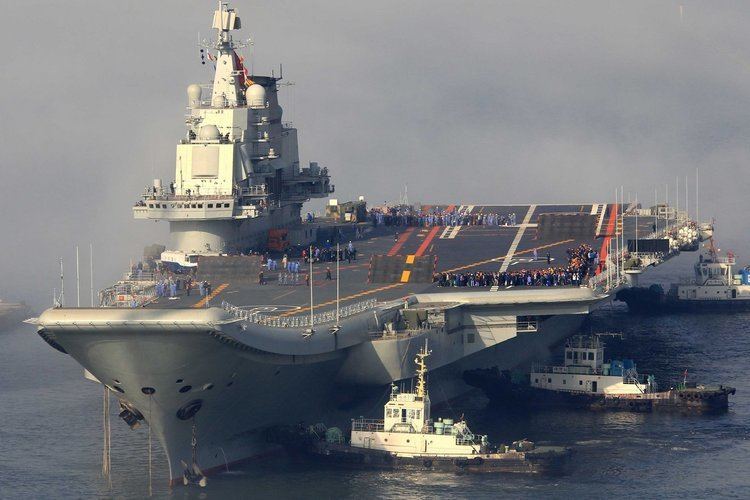
In 1998, the rusting hulk was sold at auction for $20 million to Agencia Turistica E Diversoes Chong Lot Limitada, a company from Macau. Chong Lot proposed to tow Varyag to Macau, where the ship would be converted into a $200 million floating hotel and casino. Western observers were suspicious, since Chong Lot had no listed telephone number, was not located at its listed address, and was run by former officers in the Chinese Navy. Officials in Macau also denied Chong Lot's application to operate a casino. However, analysts noted that Varyag had deteriorated too much to be used as an operational warship and pointed out that the Chinese Navy was concentrating on submarines. The Soviet carriers Kiev and Minsk had also been sold to China as tourist attractions.
In January 2015, further details emerged in an interview with Xu Zengping by the South China Morning Post. Xu reported that he had been commissioned by the PLAN to purchase the vessel on its behalf, with the floating hotel and casino as a cover story. He was warned that the Chinese Navy did not have the budget to buy the ship, and Beijing did not support the purchase. However, Xu was so impressed when touring the ship that he resolved to purchase it using his personal funds. The previous year, Xu had borrowed HK$230 million from a Hong Kong business friend, spending HK$6 million to create Chong Lot as a Macau shell corporation. He described a harrowing negotiation in Kiev, lubricated by bribery and liquor, which helped to arrange victory at the auction. As a precaution, he shipped 40 tonnes of the carrier's blueprints to China overland in eight trucks.
Transfer to China
The passage from Ukraine to China was even more problematic than the purchase. In June 2000, Varyag was taken under tow. As the tugboat approached the Bosphorus, Turkey denied permission for the ship to pass through, citing the risk that a gust of wind would turn the ship widthwise and block the entire strait. Varyag spent the next 16 months being towed counterclockwise around the Black Sea, racking up towing charges of $8,500 a day as Chong Lot stopped paying its bills. The tugboat operator compared its fate to the Yellow Fleet that was stuck in the Suez Canal for eight years, and French thrillseekers even landed a helicopter on the aircraft carrier. Meanwhile, Chinese officials negotiated with Turkey, offering trade and tourism concessions.
In August 2001, Turkey relented and agreed to allow the ship to pass. On November 1, 2001, the Bosphorus was cleared of all other traffic as Varyag was towed through. On November 2, Varyag also passed through the Dardanelles without incident. On November 4, Varyag was caught in a force 10 gale and broke adrift while passing the Greek island of Skyros. The ship was finally taken back under tow on November 6, after one sailor died while attempting to attach the tow lines.
The Suez Canal does not permit passage of "dead" ships — those without an on-board power source — so the hulk was towed through the Strait of Gibraltar, around the Cape of Good Hope, and through the Straits of Malacca at an average speed of 6 knots (11 km/h) across the 15,200-nautical-mile (28,200 km) journey. The tugboat fleet called for supplies enroute at Piraeus, Greece; Las Palmas, Canary Islands; Maputo, Mozambique; and Singapore. Varyag entered Chinese waters on February 20, 2002, and arrived March 3 at the Dalian naval shipyard in northeast China. The costs included $25 million to the Ukrainian government for the hull, nearly $500,000 in transit fees and $5 million for 20 months of towing fees.
Xu Zengping estimated in 2015 that his total out of pocket cost was at least US$120 million. He insisted that he had never been reimbursed by the Chinese government, and had spent the last 18 years repaying his debts, in part by selling properties such as his palatial home. A source familiar with the acquisition explained that many of the naval officials initiating the mission had either died or were in jail.
Contrary to initial reports that the ship had no engines, Xu reported that all four original engines remained intact at the time of purchase, but had been shut down and preserved in grease seals. A refit restored them to working order in 2011.
Modernization and refit
Varyag was moved in June 2005 to a dry dock at Dalian (38.935°N 121.6141°E / 38.935; 121.6141 (Varyag)). Her hull was sandblasted, scaffolding erected, and the ship's island was painted in a red marine primer to treat metal corrosion.
Observers have noted the installation of Type 348 active electronically scanned array (AESA) Radar (four arrays) and Sea Eagle radar. The air defense system consists of the Type 1030 CIWS and the FL-3000N missile system. The anti-ship missile tubes would not be used, freeing up internal space for hangar or storage use. Russia has explored similar modifications to her sister ship Admiral Kuznetsov.
On June 8, 2011, General Chen Bingde made the first public acknowledgement of the ship's refit. On July 27, 2011, the Chinese Defense Ministry announced it was refitting the vessel for "scientific research, experiment and training".
Sea trials and handover
The ship undertook her first sea trials from 10 August 2011 to 15 August 2011. On 29 November 2011 the carrier left port for her second set of trials. The carrier completed her eighth sea trial between 7 June and 21 June 2012 and returned to Dalian. In July 2012, the ship set out for the longest trials thus far, 25 days. The carrier completed sea trials in early August 2012 and loaded Shenyang J-15 aircraft and KJ-88, YJ-83K, and YJ-91 missiles in preparation for weapons systems trials.
During sea trials, Liaoning experienced a steam burst in the engine compartment which forced crew to evacuate some parts of the ship, and the ship lost power. The problem was ultimately resolved and power was restored, although the time duration of the problem has not been released by military officials. Her sister ship Kuznetsov has also been disabled several times by engine failures.
On 23 September 2012, the aircraft carrier was handed over to the PLAN, and was commissioned on 25 September 2012. At the commissioning ceremony, the carrier was officially named Liaoning, in honour of the province in which she was retrofitted. On 26 December 2012, the People's Daily reported that it would take four to five years for the Liaoning to reach full capacity. As it is currently a training ship, Liaoning is not assigned to any of China's operational fleets.
According to geopolitical analysts, China could use Liaoning and its future carriers to intimidate other smaller countries that have territorial claims in the South China Sea, as well as extending air control further south of the disputed region. In December 2016 the ship exercised in the Western Pacific, including passing through the Miyako Strait between the Japanese islands of Miyako-jima and Okinawa.
Aircraft handling
On 4 November 2012, the People's Liberation Army's website (Chinese: 中国军网) reported that Shenyang J-15s had performed carrier touch-and-go training. On 25 November 2012, China announced that J-15s had made five successful arrested landings on Liaoning. In June 2013, a second round of flight tests began on board Liaoning, with personnel from the fleet air arm of the Brazilian Navy providing carrier training support to the PLAN.
In August 2014, based on an article from Chinese state media, western news outlets reported that two pilots had been killed testing jets slated to operate from Liaoning. Chinese military officials stated such reports were misleading, and clarified that deaths were in fact unrelated with tests on the carrier. The original Chinese article from Xinhua also did not link the deaths with the J-15 nor mention any loss of such aircraft.
In August 2014, the Chinese-language Shanghai Morning Post listed that Liaoning would carry 36 aircraft: 24 Shenyang J-15 fighters, six Changhe Z-18F anti-submarine warfare (ASW) helicopters, four Changhe Z-18J airborne early warning helicopters and two Harbin Z-9C rescue helicopters. The Chinese carrier aircraft inventory is similar to a balanced combat and support aircraft approach intended for Soviet aircraft carriers, which supported nuclear submarines, large surface combatants, and land-based strike bombers performing anti-access roles. The air wing lacks long-range radar and anti-submarine fixed-wing aircraft, needing support from shore-based aircraft such as Tupolev Tu-154 ASW and Shaanxi Y-8 AWACS aircraft. The U.S. Department of Defense noted that J-15s will have below normal range and armament when operating from the carrier, due to limits imposed by the ski-jump takeoff system. The lack of a carrier onboard delivery aircraft like the United States Navy (USN) Grumman C-2 Greyhound also limits logistics capabilities. Liaoning would need extensive land-based support to oppose a USN carrier strike group; however, it would be potent against the Vietnam People's Navy and the Philippine Navy. Deficiencies will likely be corrected with future aircraft carriers, which are expected to be larger with conventional takeoff decks and catapult launching for heavier fighters, plus fixed-wing radar and anti-submarine patrol aircraft.
